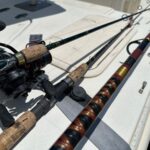Crappie fishing and fly fishing are rarely spoken in the same sentence but those who have tried it, don’t look back.
Crappie are found in each of the lower 48 states and in a variety of waterways.
They will eat a variety of presentations and, in my opinion, have some of the tastiest meat of all freshwater fish species.
With this being said, the following article will go over six of the best crappie flies to try next time your chasing slabs!
This page contains affiliate links. As an Amazon Associate, I earn from qualifying purchases.
Table of Contents
1. The Clouser Minnow
The Clouser Minnow, designed by Bob Clouser, is an all-time classic and for a reason. Tied in 1987, it is still fished by some of the greatest fishermen of all time, and should be in everyone’s box.
The clouser minnow is great for mimicking baitfish, and can be tied in a variety of colors to most accurately mimic the baitfish in your water. You can also tie it in a crawfish colorway and fish it close to the bottom to mimic a swimming crawdad.
And since Crappie feed all year on minnows (fathead minnows, mosquitofish, common minnows etc) its no wonder why the standard clouser minnow is #1 on our list!
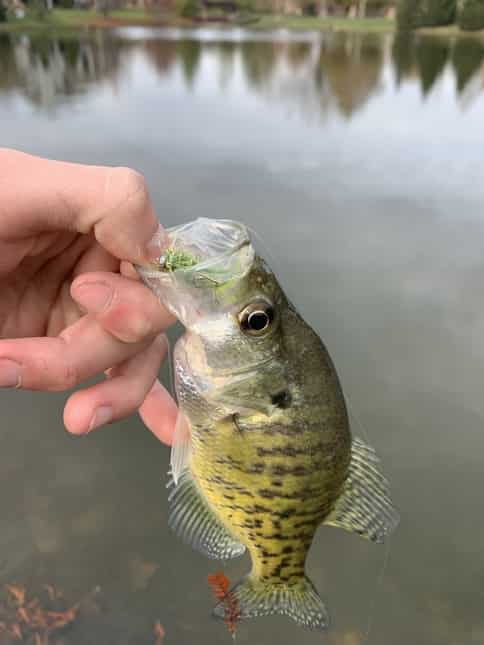
How to Fish it
There’s no single way to fish a clouser because it depends on how the fish are feeding on a particular day. If you find that the fish are very active and shallow, try fishing this fly on a floating line, and strip fast.
If you are fishing deeper water, put on an intermediate sinking line, and strip the fly in. If you want to drastically increase your chances of a hookup, fish your streamer with varying stripping cadences.
Fish with a strip, strip pause to start. If you find the fish are not reacting, try slowing down or speeding up how fast you strip, until you can identify a pattern with the fish.
2. The Wooly Bugger
The wooly bugger is perhaps one of the most effective flies ever created and can imitate a wide variety of things. It works on a number of species, including crappie.

You don’t need to get fancy with your wooly buggers. I recommend carrying an assortment of wooly buggers in a variety of simple colors.
I always carry a few brown, olive, black, and white wooly buggers. This ensures coverage for most bodies of water. At times, you may find that fish are really keying in on a certain color of jig or bait fish. In this case, use a wooly bugger that matches the color the fish are keying on.
How To Fish It
Like other streamers, it is important to get your fly down in front of the fish’s face. In deep water, you may find success using an intermediate to a full sinking fly line.
If you are fishing a body of shallow water try using a floating line with a fluorocarbon leader. Remember to vary your stripping cadences, and retrieval speeds until you identify a pattern that works.
3. The DDH Leech
The DDH leech is a lesser known fly but it can be a powerful tool in a fly fisherman’s arsenal of flies. Originally tied by Stu Thompson in Manitoba, this fly has been used extensively across the world and has been credited for catching 96 fish species to date.
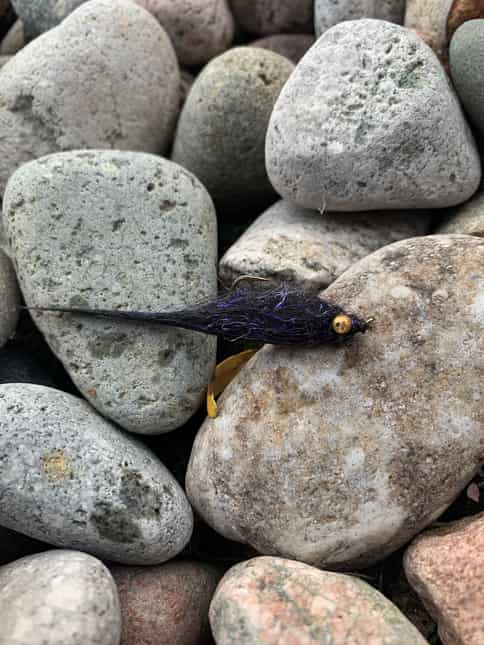
To say this fly works is an understatement…it simply catches!
Like a Wooly Bugger, a DDH leech is a very simple pattern to tie and allows the angler to carry a wide variety of colors. The various colors empower fly fishermen to dial up different options for different circumstances.
Whether you like to fish natural baitfish colors, or bright reactionary colors, both can be extremely effective when tied on a DDH leech.
A DDH leech is tied with bead chain eyes of varying sizes at the front of the fly. This allows the fly to carry a jigging action through the water while keeping the amazing, nonstop action of the marabou tail.
I like to fish the DDH leech a little differently than a wooly bugger. I usually fish it on an intermediate sinking line so the fly gets down faster.
Then, I strip just a little faster than I would on the other streamer patterns to allow for that jigging action to really shine through the water.
4. Low Fat Minnow
The low fat minnow is a smaller version of the famous baby fat minnow tied by Clark Pierce or better known in the fishing community as Cheech. The original baby fat minnow is an amazing small baitfish pattern.

On those days when you know you’re in the right spot, but just can’t get the fish to bite, the smaller low fat minnow might be just the thing you need!
If you have ever seen the low fat minnow in the water, you would know that it looks almost identical to a small swimming minnow. For a more effective use, it can also be tied in a variety of colors to match the baitfish in your body of water.
How to Fish it
To fish a baby fat minnow, you almost exclusively need to use a sinking line because the fly itself weighs very little.
Fish this fly slightly slower than some of the other flies discussed in this post, because the fly needs time to get down in the water column.
This method works very well when I’m targeting crappie from the bank. You need that sinking line to reach those fish holding in deep holes or ledges.
Furthermore, it is common for minnows and other baitfish to pause in the water column and this is oftentimes when you will get your hit!
5. Micro Jig
A micro jig is one of the more controversial topics in fly fishing. Some say it’s not a true fly because it’s tied on a jig head. Others say it is a fly because you can get all the materials you need at a fly shop and it can be fished on a fly rod.

Mini Jig or (Micro Jig) fishing was partially made popular when people down south on the Arkansas and Missouri tailwaters found out they could fish these little jigs extremely effectively for big trout on a fly rod.
Since then, more and more people have been experimenting with these easy-to-tie, fish-catching machines.
How to choose a mini jig
One of the most important things to look at when choosing a mini jig to fish, is to look at the size of the jighead.
You are looking for a jig head from roughly 1/84 of an ounce to 1/124 of an ounce. These super-small jig heads will allow you to cast the jigs easily with just enough weight to get the fly down and give it a jigging action.
How to fish a mini jig
There is really no wrong way to fish a mini jig, however, some are more effective than others. When the crappie are suspended, tie your mini jig under an indicator, then use the strip-strip pause method as you slowly inch your way across the surface.
If the crappie are holding in some current, one very effective fishing method can be to tie on your micro jig and fish it like a traditional streamer. The jighead will allow for a large jigging action, which may entice a bite.
6. Craft Fur Baitfish
It’s no secret that crappie love baitfish! That’s why the craft fur baitfish can be such an amazing fly to target crappie. It can be tied in a variety of colors and sizes to mimic baitfish of all sizes.
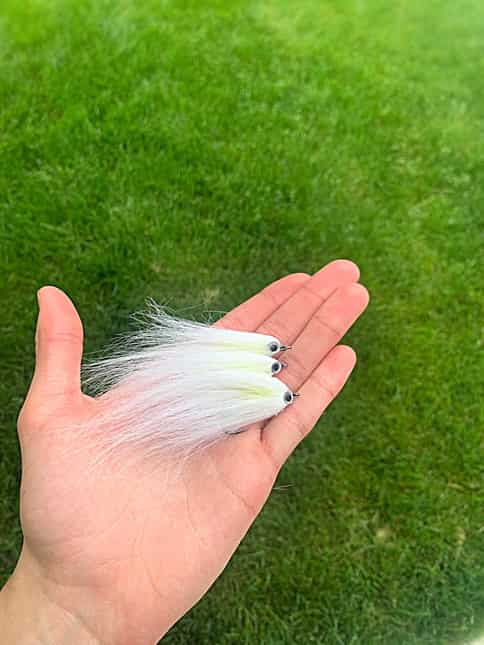
To fish a craft fur baitfish, use a sinking line and begin your stripping retrieve with a strip, pause, strip, strip technique. This will allow the craft fur fibers to really expand, flow on the pause and then move again on the strips.
Don’t be afraid to tie on a larger craft fur baitfish then you think the crappie will eat. I have caught some of my biggest crappie fishing for bass with large craft fur baitfish.
Final Thoughts
Crappie are fish that are extremely fun to target on the fly rod! Don’t be afraid to switch up flies, colors, or the size if you aren’t getting bites. It’s amazing just how drastically the bite can change with one small adjustment.
Like this post? Follow me on Pinterest.

You May Also Like: What Is The Difference Between Black and White Crappie?
If you haven’t guessed yet, I love fishing and everything about it!
To learn more about why I started Panfish Nation, visit the About page and follow along on Social Media:


Download a copy of my FREE Lure Color Selection Chart & Knot Guide!
Stay up to date with fishing reports, tackle reviews, industry news, and much more! We respect your privacy, unsubscribe at any time.
- Sauger vs Walleye: Learn These Differences and Catch More!
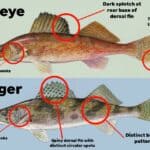
- How To Hold A Bluegill: Tips and Best Practices
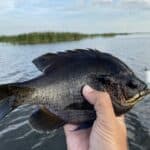
- How To Catch Wild Shiners For Bait (Step By Step W/Pics)
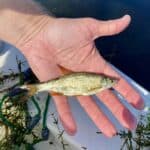
- Crazy Facts About the World Record Crappie

- What Size Hooks for Smallmouth Bass? Quick Guide

- Large and in Charge-Mouth: 10 of the Best Bass Lures of All Time (And Where to Buy Them)

- Emperor of the Sun(fish): What You Need to Know About the World Record Bluegill
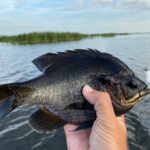
- The Seven Best Lures for Fall Bass Fishing
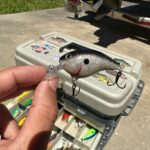
- Which Fishing Line is Best for Bass Fishing With A Spinning Reel?
